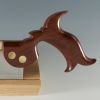So I'm having some issues resawing some 10 & 13 inch wide ash. It is curling up in both directions. The rough lumber was 6/4. I tried resawing it 2 different ways - after jointing and planing down to about 1 1/8 inch and resawing a rough piece. My ultimate goal is to plane it down to 3/8 of inch for ship lapped back panels of a train display case that will be 36" tall. I had this same thing happen a little over a year ago with some red oak for a similar project.
I've attached pictures and was wondering if anyone could tell me what I am doing wrong.
Attachment 227592




 Reply With Quote
Reply With Quote








